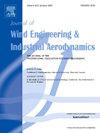A simple method for predicting the distribution and magnitude of the pressure peaks in the tunnel induced by the passing train
IF 4.9
2区 工程技术
Q1 ENGINEERING, CIVIL
Journal of Wind Engineering and Industrial Aerodynamics
Pub Date : 2025-10-07
DOI:10.1016/j.jweia.2025.106244
引用次数: 0
Abstract
When a high-speed train passes through a tunnel, significant transient pressure is generated in the tunnel, which has an adverse effect on both the tunnel and train structures. In this study, a simple method was proposed to predict the pressure peaks in a tunnel. This method is based on the train wave signature (TWS) method, which has been proposed by previous scholars. The theoretical formulas were established to calculate the location and magnitude of both positive and negative peaks in a tunnel during train passage and after the train tail has exited. This simple method significantly reduces computational resources while maintaining prediction accuracy. Additionally, theoretical formulas were established to determine the most unfavorable tunnel length based on the pressure peaks along the tunnel wall. The accuracy of all the theoretical results was validated through three-dimensional numerical simulations and previous similar studies.
一种预测行车引起的隧道压力峰分布和大小的简单方法
高速列车通过隧道时,隧道内会产生较大的瞬态压力,对隧道和列车结构都产生不利影响。本文提出了一种预测隧道压力峰值的简单方法。该方法是在前人提出的列车波特征(TWS)方法的基础上提出的。建立了列车通行过程中和列车尾部退出后隧道内正负峰的位置和大小的理论计算公式。这种简单的方法在保持预测精度的同时显著减少了计算资源。建立了基于沿壁压力峰值确定最不利隧道长度的理论公式。通过三维数值模拟和前人的类似研究,验证了理论结果的准确性。
本文章由计算机程序翻译,如有差异,请以英文原文为准。
求助全文
约1分钟内获得全文
求助全文
来源期刊
CiteScore
8.90
自引率
22.90%
发文量
306
审稿时长
4.4 months
期刊介绍:
The objective of the journal is to provide a means for the publication and interchange of information, on an international basis, on all those aspects of wind engineering that are included in the activities of the International Association for Wind Engineering http://www.iawe.org/. These are: social and economic impact of wind effects; wind characteristics and structure, local wind environments, wind loads and structural response, diffusion, pollutant dispersion and matter transport, wind effects on building heat loss and ventilation, wind effects on transport systems, aerodynamic aspects of wind energy generation, and codification of wind effects.
Papers on these subjects describing full-scale measurements, wind-tunnel simulation studies, computational or theoretical methods are published, as well as papers dealing with the development of techniques and apparatus for wind engineering experiments.

 求助内容:
求助内容: 应助结果提醒方式:
应助结果提醒方式:


